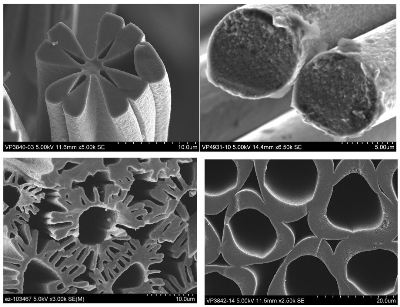Researchers at the Department of Energy’s Oak Ridge National Laboratory (ORNL) have developed a novel process to convert polyethylene into valuable carbon fiber.
 Carbon fibers having unique surface geometries, from circular to hollow gear-shaped, are produced from polyethylene using a versatile fabrication method. The resulting carbon fiber exhibits properties that are dependent on processing conditions, rendering them highly amenable to myriad applications.
Carbon fibers having unique surface geometries, from circular to hollow gear-shaped, are produced from polyethylene using a versatile fabrication method. The resulting carbon fiber exhibits properties that are dependent on processing conditions, rendering them highly amenable to myriad applications.
Amit Naskar at ORNL’s Materials Science and Technology Division led the team. The team devised a method to modify the final carbon fiber produced as required for specific applications. They employed multi-component fiber spinning and a sulfonation technique to reduce the diameter of polyethylene-base fiber filaments to submicron levels and produce fibers having customized surface contours. They were able to adjust the porosity of the material, which allows it to be used for filtration, electrochemical energy harvesting and catalysis.
Naskar stated that a flexible technique for manufacturing innovative fibers in various configurations, including non-woven mat or fiber bundle assemblies, can be realized in the future. In this project, the team developed carbon fibers having hollow circular, and gear-shaped cross-sectional geometry by employing a fiber spinning method based on multi-component melt extrusion.
In this process, the fiber bundle is dipped into chemical bath acid. Here it undergoes a reaction and forms a non-melting black fiber. The molecules of the plastic bond and do not melt on additional heating. The carbon fiber volatizes all other elements except the carbon, at such high temperatures.
The U.S. DOE is seeking progress in lightweight materials for the automobile sector, which will lead to savings in fuel. Further, the raw material required for producing these carbon fibers can be derived from plastic bags, salvage and scrap.
The study was published in Advanced Materials.